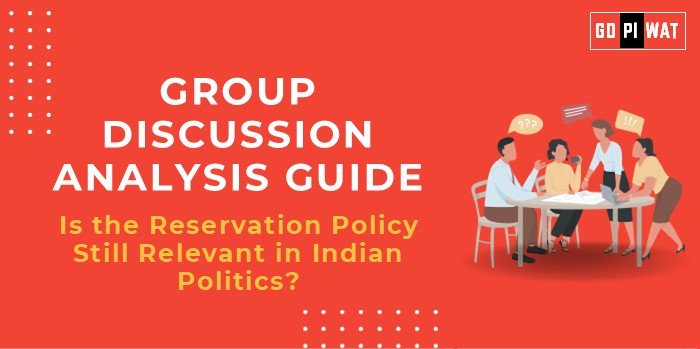📋 Group Discussion (GD) Analysis Guide: Is the Reservation Policy Still Relevant in Indian Politics?
🌐 Introduction to the Topic
- 📖 Opening Context: The reservation policy has been a cornerstone of India’s socio-political framework since independence, designed to address historical injustices and ensure equitable representation in education, employment, and politics.
- 🌍 Topic Background: Introduced as a measure to uplift historically marginalized communities, reservations initially focused on Scheduled Castes (SCs), Scheduled Tribes (STs), and later Other Backward Classes (OBCs). Recent demands for economically weaker section (EWS) reservations and regional protests have reignited debates about its relevance today.
📊 Quick Facts and Key Statistics
- 📋 Reservation Quota: 49.5% for SC, ST, OBC in central institutions.
- 📜 EWS Quota: 10% added in 2019 under the 103rd Constitutional Amendment.
- 🏛️ Representation: SCs/STs hold ~25% of parliamentary seats due to reserved constituencies.
- 📈 Educational Enrolment: GER (Gross Enrolment Ratio) for SCs: 23.4% (2019-20), improving but still below the national average of 27.1%.
🤝 Stakeholders and Their Roles
- 🏛️ Government: Policy formulation and monitoring of implementation; ensures reservation adherence.
- 🎓 Institutions: Implement reservation in educational and professional domains.
- 👥 Marginalized Communities: Primary beneficiaries advocating for more inclusive approaches.
- 📢 General Public: Often divided over issues of meritocracy vs. affirmative action.
🏆 Achievements and Challenges
✨ Achievements:
- ✅ Increased Representation: Significant political and academic opportunities for SCs, STs, and OBCs.
- 📖 Educational Upliftment: Enhanced literacy rates among marginalized groups.
- ⚖️ Social Equity: Reduced caste-based discrimination in public institutions.
⚠️ Challenges:
- 🎭 Meritocracy Debate: Concerns about compromising merit-based selection.
- ⚖️ Policy Abuse: Affluent within reserved categories benefiting disproportionately (creamy layer issues).
- 📉 Exclusion: Lack of benefits for genuinely needy individuals outside reserved categories.
🌏 Global Comparisons:
- 🇺🇸 USA (Affirmative Action): Focus on racial diversity in education and jobs.
- 🇿🇦 South Africa: Similar policies for racial equity post-apartheid.
📄 Case Studies:
- 📌 Tamil Nadu Model: 69% reservation, success in creating a more inclusive workforce but criticized for merit dilution.
- 📌 Andhra Pradesh: Policies aimed at backward class upliftment with significant grassroots impact.
💡 Structured Arguments for Discussion
- 📢 Supporting Stance: “The reservation system continues to be critical for addressing systemic inequality and ensuring representation.”
- ❌ Opposing Stance: “Reservations hinder meritocracy and create divisions within society.”
- ⚖️ Balanced Perspective: “While reservations are vital for equity, reforms are necessary to target genuine beneficiaries.”
📌 Effective Discussion Approaches
🎯 Opening Approaches:
- 📊 Quote statistics about reservation’s role in education or politics.
- 🌍 Use global examples of affirmative action for perspective.
🔄 Counter-Argument Handling:
- ⚖️ Meritocracy vs. equity: Highlight economic reservation (EWS) as a balancing approach.
- 📖 Case study references to Tamil Nadu or the USA for solutions.
📚 Strategic Analysis of Strengths and Weaknesses
- 💪 Strengths:
- ⚖️ Social justice promotion.
- 📋 Increased representation.
- ❌ Weaknesses:
- 📉 Over-reliance on reservations.
- ⚠️ Lack of dynamic review mechanisms.
- ✨ Opportunities:
- 📜 Economic-based reservations.
- 🛠️ Policy refinement.
- ⚠️ Threats:
- 📢 Social unrest.
- ⚖️ Political misuse.
🎓 Connecting with B-School Applications
🌐 Real-World Applications:
- 📊 Policy review projects.
- 📋 Diversity management in organizations.
❓ Sample Interview Questions:
- ❓ “Is the current reservation policy sufficient for inclusivity?”
- 💡 “How can India balance meritocracy with affirmative action?”
📈 Insights for B-School Students:
- 📖 Research potential reforms in the reservation policy.
- ⚖️ Understand policy impacts on human resource diversity.


